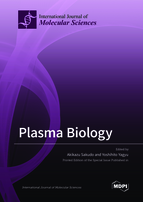Plasma Biology
A special issue of International Journal of Molecular Sciences (ISSN 1422-0067). This special issue belongs to the section "Molecular Biophysics".
Deadline for manuscript submissions: closed (31 March 2021) | Viewed by 60911
Special Issue Editors
Interests: antimicrobial resistance; bacteria; disinfectants; disinfection and sterilization technologies; food safety; infectious diseases; medical device; prion; public health; virus
Special Issues, Collections and Topics in MDPI journals
Interests: plasma technology
Special Issues, Collections and Topics in MDPI journals
Special Issue Information
Dear Colleagues,
Irving Langmuir coined the name “plasma” to describe an ionized gas back in 1927. Just over 90 years later, plasma technology is becoming increasingly important in our daily life. For example, in the medical field and dentistry, plasma is used as a method of disinfection/sterilization. Moreover, additional potential novel applications of this technology in different forms of therapy have been proposed. In the agricultural sector, plasma technology could contribute to higher crop yields by enhancing seed germination and the growth of plants as well as the preservation of foods by disinfection. Plasma technology could also be utilized in environmental applications including water treatment and remediation as well as treatment of exhaust gases. Although recent extensive studies have uncovered the broad potential of plasma technology, its mechanisms of action remain unclear. Therefore, further studies aimed at elucidating the molecular mechanisms of plasma technology are required. This special issue calls for original articles and reviews investigating the molecular mechanisms of plasma biology. Relevant areas of study include applications in plasma medicine, plasma agriculture, plasma environmental science as well as plasma chemistry. Studies on therapeutic approaches using plasma itself and plasma-treated solutions are also welcome.
You may choose our Joint Special Issue in Plasma.
Dr. Akikazu Sakudo
Dr. Yoshihito Yagyu
Guest Editor
Manuscript Submission Information
Manuscripts should be submitted online at www.mdpi.com by registering and logging in to this website. Once you are registered, click here to go to the submission form. Manuscripts can be submitted until the deadline. All submissions that pass pre-check are peer-reviewed. Accepted papers will be published continuously in the journal (as soon as accepted) and will be listed together on the special issue website. Research articles, review articles as well as short communications are invited. For planned papers, a title and short abstract (about 100 words) can be sent to the Editorial Office for announcement on this website.
Submitted manuscripts should not have been published previously, nor be under consideration for publication elsewhere (except conference proceedings papers). All manuscripts are thoroughly refereed through a single-blind peer-review process. A guide for authors and other relevant information for submission of manuscripts is available on the Instructions for Authors page. International Journal of Molecular Sciences is an international peer-reviewed open access semimonthly journal published by MDPI.
Please visit the Instructions for Authors page before submitting a manuscript. There is an Article Processing Charge (APC) for publication in this open access journal. For details about the APC please see here. Submitted papers should be well formatted and use good English. Authors may use MDPI's English editing service prior to publication or during author revisions.
Keywords
- discharge
- dinsifection
- inactivation
- plasma-activated solutions
- plasma agriculture
- plasma dentistry
- plasma environmental science
- plasma medicine
- plasma therapy
- sterilization
Related Special Issues
- Plasma Biology in Plasma (1 article)
- Plasma Biology 2.0 in International Journal of Molecular Sciences (8 articles)
- Plasma Microbiology in International Journal of Molecular Sciences (2 articles)








